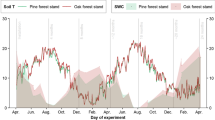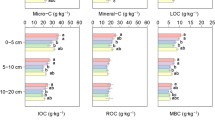Abstract
Litter decomposition in forests is affected by tree species composition which produces litters with specific characteristics and alters soil surface conditions and nutrient availability. The impact of such changes in soil microsite conditions on litter decomposition is however poorly elucidated. We studied the decomposition of sugar maple leaves in 22 plots varying from pure hardwoods to mixedwoods to conifer-dominated stands across four sites in the sugar maple bioclimatic domain in Quebec. Mass loss and nutrient release were assessed over a 2-year experiment. Proxies of moisture availability measured under the canopy were more valuable for explaining the variability in leaf litter decomposition rates than soil temperature, litter quality and general site measurements (e.g. air temperature, rainwater). Throughfall amounts and soil volumetric water content (VWC) explained 56% of the variability in mass loss constants. Sugar maple leaf litter under hardwoods also decomposed more rapidly than under conifer-dominated stands. Slower litter decomposition under conifer-dominated stands was again more largely controlled by the lower soil VWC than the more acidic forest floor created by the needles. This study highlights that proxies of moisture availability measured at the microsite level can be key variables to predict litter dynamics in forests.







Similar content being viewed by others
References
Aerts R (2006) The freezer defrosting: global warming and litter decomposition rates in cold biomes. J Ecol 94:713–724
Attiwil PM (1968) The loss of elements from decomposing litter. Ecology 49:142–145
Bååth E, Anderson T-H (2003) Comparison of soil fungal/bacterial ratios in a pH gradient using physiological and PLFA-based techniques. Soil Biol Biochem 35:955–963
Barbier S, Balandier P, Gosselin F (2009) Influence of several tree traits on rainfall partitioning in temperate and boreal forests: a review. Ann For Sci 66:1–11
Berg B, McClaugherty CA (2008) Plant litter, 2nd edn. Springer, New York
Binkley D, Fisher R (2012) Ecology and management of forest soils. Wiley, New York
Binkley D, Giardina C (1998) Why do tree species affect soils? The warp and woof of tree-soil interactions. Biogeochemistry 42:89–106
Blair JM (1988a) Nutrient release from decomposing foliar litter of three tree species with special reference to calcium, magnesium and potassium dynamics. Plant Soil 110:49–55
Blair JM (1988b) Nitrogen, sulfur and phosphorus dynamics in decomposing deciduous leaf litter in the southern Appalachians. Soil Biol Biochem 20:693–701
Bradford MA, Ii RJW, Baldrian P, Crowther TW, Maynard DS, Oldfield EE, King JR (2014) Climate fails to predict wood decomposition at regional scales. Nat Clim Change 4:625–630
Bradford MA, Berg B, Maynard DS, Wieder WR, Wood SA (2016) Understanding the dominant controls on litter decomposition. J Ecol 104:229–238
Bradford MA, Veen GF, Bonis A, Bradford EM, Classen AT, Cornelissen JHC, Crowther TW, De Long JR, Freschet GR, Kardol P, Manrubia-Freixa M, Maynard DS, Newman GS, Logtestijn RSP, Viketoft M, Wardle DA, Wieder WR, Wood SA, van der Putten WH (2017) A test of the hierarchical model of litter. Nat Ecol Evol 1:1836–1845
Buczko U, Bens O, Hüttl RF (2006) Water infiltration and hydrophobicity in forest soils of a pine-beech transformation chronosequence. J Hydrol 331:383–395
Chang M (2012) Forest Hydrology. CRC Press
Collin A, Messier C, Bélanger N (2017) Conifer presence may negatively affect sugar maple’s ability to migrate into the boreal forest through reduced foliar nutritional status. Ecosystems 20:701–716
Collin A, Messier C, Kembel SW, Bélanger N (2018) Can sugar maple establish into the boreal forest? Insights from seedlings under various canopies in southern Quebec. Ecosphere 9:e02022
Didion M, Repo A, Liski J, Forsius M, Bierbaumer M, Djukic I (2016) Towards harmonizing leaf litter decomposition studies using standard tea bags-a field study and model application. Forests 7:167
Djukic I, Kepfer-Rojas S, Kappel Schimdt I, Steenberg Larsen K, Beier C, Berg B, Verheyen K (2018) Early stage litter decomposition across biomes. Sci Total Environ 628–629:1369–1394
Dray S, Bivand R, Legendre P, Oksanen J, Blanchet F, Solymos P (2013) Packfor: Forward selection with permutation (Canoco p. 46) v. 0.8
Fioretto A, Di Nardo C, Papa S, Fuggi A (2005) Lignin and cellulose degradation and nitrogen dynamics during decomposition of three leaf litter species in a Mediterranean ecosystem. Soil Biol Biochem 37:1083–1091
García Palacios P, Shaw EA, Wall DH, Hättenschwiler S (2016) Temporal dynamics of biotic and abiotic drivers of litter decomposition. Ecol Lett 19:554–563
Gosz JR, Likens GE, Bormann FH (1973) Nutrient release from decomposing leaf and branch litter in the Hubbard Brook Forest, New Hampshire. Ecol Monogr 43(2):173–191
Hothorn T, Bretz F, Westfall P, Heiberger R (2008) Multcomp: simultaneous inference for general linear hypotheses. R Package Version 1.0–3
Ise T, Moorcroft PR (2006) The global-scale temperature and moisture dependencies of soil organic carbon decomposition: an analysis using a mechanistic decomposition model. Biogeochemistry 80:217–231
Joly F-X, Milcu A, Scherer-Lorenzen M, Jean L-K, Bussotti F, Dawud SM, Müller S, Pollastrini M, Raulund-Rasmussen K, Vesterdal L, Hättenschwiler S (2017) Tree species diversity affects decomposition through modified micro-environmental conditions across European forests. New Phytol 214:1281–1293
Keiser AD, Knoepp JD, Bradford MA (2016) Disturbance decouples biogeochemical cycles across forests of the southeastern US. Ecosystems 19:50–61
Levin SE (1992) The problem of pattern and scale in ecology. Ecology 73:1943–1967
Liechty HO, Holmes MJ, Reed DD, Mroz GD (1992) Changes in microclimate after stand conversion in two northern hardwood stands. For Ecol Manag 50:253–264
Lovett GM, Nolan SS, Driscoll CT, Fahey TJ (1996) Factors influencing throughfall flux in a New Hampshire forested landscape. Can J For Res 26:2134–2144
Mazerolle M (2015) AICcmodavg: model selection and multimodel inference based on (Q) AIC (C). R package version 2.0-3
Melillo JM, Aber JD, Muratore JF (1982) Nitrogen and lignin control of hardwood leaft litter decomposition dynamics. Ecology 63:621–626
Oksanen J, Blanchet FG, Kindt R, Legendre P, Minchin PR, O’Hara R, Simpson GL, Solymos P, Stevens M, Wagner H (2013) Community Ecology Package ‘vegan’. R package version 2.0-10
Parker GG (1983) Throughfall and stemflow in the forest nutrient cycle. Adv Ecol Res 13:57–133
Pinheiro J, Bates D, DebRoy S, Sarkar D (2014) nlme: linear and nonlinear mixed effects models. R package version 3.1–117
Prescott CE (2010) Litter decomposition: what controls it and how we can alter it to sequester more carbon in forest soils? Biogeochemistry 101:133–149
R Core Team (2013) R: a language and environment for statistical computing. R Foundation for Statistical Computing
Régnière J, Bolstad P (1994) Statistical simulation of daily air temperature patterns eastern North America to forecast seasonal events in insect pest management. Environ Entomol 23:1368–1380
Régnière J, St-Amant R (2007) Stochastic simulation of daily air temperature and precipitation from monthly normals in North America north of Mexico. Int J Biometeorol 51:415–430
Roe S, Lawrence D, Wood TE, Reed S, Cavaleri MA, Alonso-Rodriguez AM, Gonzalez G (2018) Warming effects on litter decomposition and carbon cycling in a tropical forest. American Geophysical Union Fall Meeting
Saucier JP, Grondin P, Robitaille A, Gosselin J, Morneau C, Richard PJH, Brisson J, Sirois L, Leduc A, Morin H, Thiffault E, Gauthier S, Lavoie C, Payette S (2009) Écologie forestière In: Manuel de foresterie, 2ième édition, Ouvrage collectif. Éditions MultiMondes et Ordre des ingénieurs forestiers du Québec, pp 165–315
Scherer-Lorenzen M (2008) Functional diversity affects decomposition processes in experimental grasslands. Funct Ecol 22:547–555
Schimel JP, Gulledge JM, Clein-Curley JS, Lindstrom JE, Braddock JF (1999) Moisture effects on microbial activity and community structure in decomposing birch litter in the Alaskan taiga. Soil Biol Biochem 31:831–838
Silver WL, Miya RK (2001) Global patterns in root decomposition: comparisons of climate and litter quality effects. Oecologia 129:407–419
Soil Classification Working Group (1998) The Canadian system of soil classification, Third edition. Agriculture and Agri-Food Canada Publication no. 1646. NRC Research Press
Strobl C, Malley J, Tutz G (2009) An introduction to recursive partitioning: rationale, application, and characteristics of classification and regression trees, bagging, and random forests. Psychol Methods 14:323
Swift MJ, Heal OW, Anderson JM (1979) Decomposition in terrestrial ecosystems. Studies in Ecology, Vol. 5. Blackwell Scientific
Taylor BR, Prescott CE, Parsons WFJ, Parkinson D (1991) Substrate control of litter decomposition in four Rocky Mountain coniferous forests. Can J Bot 69:2242–2250
Todd-Brown KEO, Randerson JT, Hopkins F, Arora V, Hajima T, Jones C, Shevliakova E, Tjiputra J, Volodin E, Wu T, Zhang Q, Allison SD (2014) Changes in soil organic carbon storage predicted by Earth system models during the 21st century. Biogeosciences 11:2341–2356
Van Breemen N, Buurman P (2002) Soil formation, 2nd edn. Kluwer Academic Publishers, London
Wardle DA, Bardgett RD, Walker LR, Bonner KI (2009) Among- and within-species variation in litter decomposition in contrasting long-term chronosequences. Funct Ecol 23:442–453
Waring B, Adams R, Branco S, Powers JS (2016) Scale-dependent variation in nitrogen cycling and soil fungal communities along gradients of forest composition and age in regenerating tropical dry forests. New Phytol 209:845–854
Yuan ZY, Chen HY (2010) Fine root biomass, production, turnover rates, and nutrient contents in boreal forest ecosystems in relation to species, climate, fertility, and stand age: literature review and meta-analyses. Crit Rev Plant Sci 29:204–221
Zhang D, Hui D, Luo Y, Zhou G (2008) Rates of litter decomposition in terrestrial ecosystems: global patterns and controlling factors. J Plant Ecol 1:1–9
Ziadi N, Sen Tran T (2007) Mehlich 3-extractable elements. In: Carter MR, Gregorich EG (eds) Soil sampling and methods of analysis. CRC Press, Boca Raton, pp 81–88
Zukswert JM, Prescott CE (2107) Relationships among leaf functional traits, litter traits, and mass loss during early phases of leaf liter decomposition in 12 woody plant species. Oecologia 185:305–316
Acknowledgements
Financial support was provided through NSERC (Natural Sciences and Engineering Research Council of Canada) Discovery Grants (RGPIN 2015-03699) to N. Bélanger, and a FODAR (Fonds de développement académique du réseau) Actions stratégiques grant to N. Bélanger, D. Rivest and S. Kembel. We thank Xavier Fournier Tréhout, Ralitsa Mincheva, Olivia Bélanger, Daniel Lesieur and Justin Bélanger for their help in the field and laboratory. We are also grateful to Hélène Lalande and Dominic Bélanger for laboratory analysis and Mélanie Desrochers for preparing Fig. 1. Finally, we thank Domtar Forest Products, the Station de biologie des Laurentides of Université de Montréal, the Ministère des Forêts, de la Faune et des Parcs (Quebec Government) and Virginie-Arielle Angers for providing access to the research sites in Windsor, St. Hippolyte, LaBlanche and Ste Agathe, respectively.
Author information
Authors and Affiliations
Corresponding author
Additional information
Responsible Editor: Susan Ziegler.
Publisher's Note
Springer Nature remains neutral with regard to jurisdictional claims in published maps and institutional affiliations.
Electronic supplementary material
Below is the link to the electronic supplementary material.
Rights and permissions
About this article
Cite this article
Bélanger, N., Collin, A., Ricard-Piché, J. et al. Microsite conditions influence leaf litter decomposition in sugar maple bioclimatic domain of Quebec. Biogeochemistry 145, 107–126 (2019). https://doi.org/10.1007/s10533-019-00594-1
Received:
Accepted:
Published:
Issue Date:
DOI: https://doi.org/10.1007/s10533-019-00594-1




